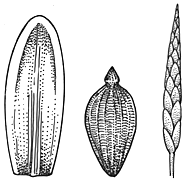Eleocharis atricha R.Br. APNI* 
Description: Slender tufted perennial, with slender rhizomes bearing ovoid tubers to c. 4 mm long and 2.5 mm diam.
Culms angular-sulcate, 3–40 cm high, 0.5–1 mm diam.
Spikelet narrow-ovoid to linear, often proliferating, 10–20 mm long. Glumes obtuse, narrowly keeled, 3–5 mm long, red-brown. Bristles absent. Stamens 3; anthers 1.5–2.6 mm. Style 3-fid.
Nut obscurely trigonous, narrow-obovoid, narrowed in a short neck, prominently vertically ribbed, the external cells transversely linear to oblong in 4 or 5 vertical rows on each face, 1.3–1.5 mm long, c. 0.7 mm diam., straw-coloured; style base a third to half as long as and three-quarters to four-fifths as broad as nut.
Flowering: spring–summer.
Distribution and occurrence: Widespread on the tablelands, extending to the coastal regions near Sydney and Yambulla State Forest, and inland to the Yetman and Albury areas. Also in SE Qld, Vic and SE SA. Grows in moist situations.
NSW subdivisions: CC, SC, NT, CT, ST, SWS, NWP
Other Australian states: Qld Vic. S.A.
Rarely sets fruit; it spreads by proliferating from the spikelet or producing tubers.
Text by K. L. Wilson (1993; edited Sept 2006; October 2019)
Taxon concept: Flora of NSW 4 (1993)
APNI* Provides a link to the Australian Plant Name Index (hosted by the Australian National Botanic Gardens) for comprehensive bibliographic data
***The AVH map option provides a detailed interactive Australia wide distribution map drawn from collections held by all major Australian herbaria participating in the Australian Virtual Herbarium project.
|


